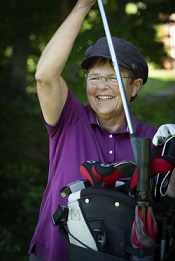Shareen Cox
Shareen now travels alone without worrying about an AFib episode
When Shareen retired in 2013, she was ready to continue her world travels and explore new places to meet new, interesting people. But a few years after retiring, she began having frequent occurrences of feeling tired and not being able to catch her breath.
Shareen had her first incident of feeling ill, unable to catch her breath and unable to lift her arms, in 2011. At that time, her primary care physician sent her to the ER suspecting a heart attack. She had a coronary angiogram and doctors found a blockage in her left main coronary artery, sometimes called a ”widowmaker.” She had open heart surgery to fix the blocked artery.
“Before I had open heart surgery, not only did the blood test show I could be having a heart attack, I had a very high heart rate,” says Shareen. “At that time, they thought it could be supraventricular tachycardia.”
Supraventricular tachycardia is a type of atrial fibrillation, or AFib, the most common type of heart arrhythmia. It is an irregular heartbeat that can lead to blood clots, stroke, heart failure and other heart-related complications.
In 2016, when the episodes began occurring frequently, Dr. Burns had Shareen wear a 30-day heart monitor to see what she was experiencing.
Shareen remembers, “At times, I was feeling a physical response. I couldn’t swing the golf club and I was unable to catch my breath. Then with the heart monitor on, they found I was having episodes a lot, even when I wasn’t feeling them.”
A heart monitor, or cardiac event recorder, is a battery-powered device you wear 24 hours a day to record your heart’s electrical activity. The device records the information and transmits the data to your doctor.
Shareen’s heart monitor showed she had frequent episodes with her heart rate exceeding 200 beats per minute, as well as incidents of irregular heartbeats. It also revealed her heart rate dropped low at night.
Shareen was referred to Electrophysiologist Dr. Mohamad Sinno with St. Elizabeth Heart & Vascular Institute, who specializes in the electrical activity of the heart, or heart rhythms.
“Because my heart rate could also drop very low, Dr. Sinno did not feel medication would be the best treatment for me,” says Shareen. “He recommended a cardiac ablation.”
During a cardiac ablation, Dr. Sinno creates a 3D map of the heart to locate the area of the heart that is sending erratic electrical impulses. A catheter is then inserted through the groin and up to the heart to deliver energy (cold or heat) to the area to destroy the tissue sending the erratic impulses. Scar tissue then forms and prevents the irregular heartbeats.
After a year with no issues, Shareen was off on another adventure—Japan. Dr. Sinno told her to send photos, so she did just that.
In the letter sent with the photos, Shareen said, “This trip was made possible due to your skill at correcting the beating of my heart. I was confident traveling alone for the last eight days after the past year with no issues. Thank you for your skill in making my life better by keeping my heart from skipping beats or beating off the tracks. Which reminds me of the Japanese train system—always on time down to the second!”

For more information about arrhythmia care at the St. Elizabeth Heart & Vascular Institute, learn more now, or call (859) 331-3353.

